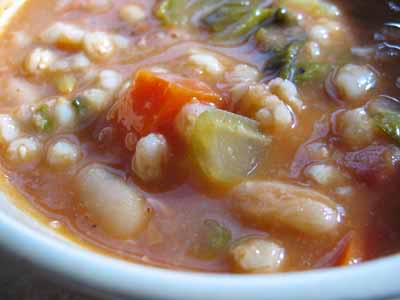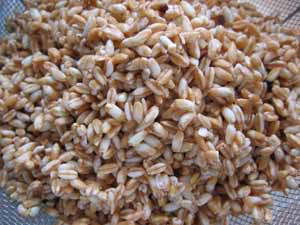
Ahh, the humble bean. What ingredient is more disparaged, yet more versatile? Sure, you might get a little, umm, musical after, but isn’t it worth it? Beans are delicious, they’re healthy, and best of all, they’re cheap. On Words to Eat By alone you’ll find them in Lentil & Brown Rice Soup, Split Pea Soup, and Curry-Roasted Chick Peas. I’ll often drain and rinse a can, then toss it into pasta primavera, vegetable soup, or a plainish salad to perk things up and add a hit of protein. So for this month’s bean-based incarnation of Is My Blog Burning, hosted by the lovely and gracious Cathy at My Little Kitchen, I wanted to add a new challenge for myself, and include an ingredient I’d never used before.
Farro. I decided I’d use farro, an Italian grain from the wheat family that I first tasted at Blue Hill at Stone Barns for my birthday dinner. Source of the Italian word for flour, farina, and similar to barley but with even more texture, it’s quite chewy and downright spunky. I found this tidbit on ItalianCookingAndLiving.com:
“Rich in fiber, magnesium, and vitamins A, B, C, and E, farro is an ideal grain, easily digested and assimilated into the system as energizing carbohydrates. And because of its low gluten content, people who are gluten-intolerant can often eat farro without difficulty. Typically grown without chemical fertilizers or pesticides, farro is an appealing choice for those who want to base their diet on pure, natural products.”
Until recently, I’d only seen it on restaurant menus, but a trip to Buon Italia at Chelsea Market yielded a vacuum-packed bag of the pointy little grain.

A quick google yielded an assortment of farro and white bean soups, so I read them all and took a pinch from this one, a smidgen from that one, until I had something that sounded like it just might work. And boy, did it ever. This soup is the definition of hearty: smoky from the buffalo bacon, with broth silkened by the farro and the pureed beans. Chunks of vegetables add a hint of sweetness to each bite. Whole beans provide a softer counterpoint. The escarole remains toothy—it holds its own against the other manly-man ingredients. By the second day, the grains of farro have absorbed so much of the liquid that they’re swollen little balls of chewy goodness, and the soup is suddenly a stew. Either way, it’s absolutely delicious.
Wow. I love this soup.

Farro & White Bean Soup with Escarole
Serves 6
1 cup farro
2 15-oz cans white beans
2 T. olive oil
2 oz. pancetta or buffalo bacon, chopped fine
1 medium onion, peeled and finely chopped
2 medium cloves garlic, peeled and minced
1 medium carrot, peeled and coarsely chopped
1 rib celery, coarsely chopped
1 sprig fresh thyme
1 sprig fresh marjoram
1 14.5-oz can diced tomatoes
Pinch nutmeg
1 parmesan rind
4 cups reduced sodium, reduced fat chicken broth
2 cups chopped escarole leaves
½ t. salt
¼ t. freshly ground black pepper
Rinse the farro in a sieve, then soak in lots of water to cover overnight. Discard any bits that float to the surface—these are hulls, and not pleasant to eat. [Another option I read but haven’t tried yet: Put farro in a pot, cover with water and bring to a boil. Reduce heat and simmer 15 minutes. Remove from heat and set aside 1 hour.] Drain well.

(farro after soaking)
Purée 1 can of beans with its liquid in a food processor or blender. Drain the other can of beans and rinse well. Set both aside.
Heat the olive oil in a large, heavy stock pot on medium heat. Add pancetta or buffalo bacon and sauté 2-3 minutes. Add onion and sauté 4 minutes. Add garlic, carrot, celery and herbs; sauté 8 minutes or until vegetables begin to soften. Stir in farro, undrained tomatoes, nutmeg, bean purée and whole beans, parmesan rind, and broth. Bring to a boil, reduce the heat and simmer 15 minutes. Stir occasionally. Add escarole, salt and pepper. Continue cooking an additional 15 minutes. Test farro for doneness—it should be softened but still have some texture. Remove herb stems before serving.

